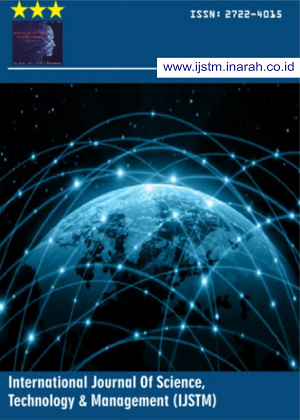Analysis of Trends and Correlation Between Ground-based PM₂․₅ and Satellite AOD in Jakarta (Dec 2022–Mar 2025)
Abstract
Monitoring of PM₂․₅ concentrations in urban areas such as Jakarta is crucial given its impact on public health (WHO, 2021) and the urban environment (Zhang et al., 2020), where measuring PM₂․₅ levels is essential for assessing air quality and health risks in metropolitan regions, including Jakarta. However, the limited number of ground-based monitoring stations and variable weather conditions often result in uneven PM₂․₅ data availability (Alim et al., 2023). As an alternative, satellite-derived Aerosol Optical Depth (AOD) can serve as a proxy for particulate pollution monitoring (Liang et al., 2018).This study aims to analyze the temporal trends and quantify the correlation between ground-based PM₂․₅ and satellite AOD in Jakarta from December 2022 through March 2025. PM₂․₅ data were obtained from five Air Quality Monitoring Stations (SPKU) located in Kebon Jeruk, Bundaran HI, Kelapa Gading, Lubang Buaya, and Jagakarsa, while AOD was extracted via Google Earth Engine (MODIS MCD19A2) at the same five locations. Key methods include additive seasonal decomposition of each time series, calculation of Pearson and Spearman correlation coefficients, and cross-correlation analysis to determine the optimal lag. The results indicate that both PM₂․₅ and AOD trends rose from mid-2023, peaked in early 2024, and then gradually declined through late 2024; monthly correlations were very strong (Pearson r = 0.71, p < 0.001; Spearman ρ = 0.76, p < 0.001). Seasonal analysis revealed concentration maxima during the dry season (June–September) and minima in the wet season (December–February). Cross-correlation shows that AOD leads PM₂․₅ fluctuations by one month (lag +1). These findings underscore the potential of satellite AOD as a monthly proxy for estimating PM₂․₅ in Jakarta, supporting more spatially and temporally comprehensive air quality monitoring than ground-based networks alone. In conclusion, satellite AOD can be used as a supplementary indicator for PM₂․₅ air quality monitoring in Jakarta, particularly to fill gaps in ground-based PM₂․₅ data coverage.
Downloads
References
. Alim, R., Putri, S., & Raharjo, H. (2023). Evaluasi ketersediaan data PM₂․₅ di DKI Jakarta. Jurnal Lingkungan Tropis, 12(1), 45–58.
. BMKG. (2023). Laporan tahunan kualitas udara DKI Jakarta. Badan Meteorologi, Klimatologi, dan Geofisika.
. Chen, L., & Sayer, A. M. (2020). Remote sensing of PM₂․₅ over South East Asia using satellite AOD data. Atmospheric Environment, 223, 117245. https://doi.org/10.1016/j.atmosenv.2020.117245
. Cleveland, R. B., Cleveland, W. S., McRae, J. E., & Terpenning, I. (1990). STL: A seasonal-trend decomposition procedure based on loess. Journal of Official Statistics, 6(1), 3–73.
. Gupta, P., & Christopher, S. A. (2021). Particulate matter air quality monitoring in urban areas: Comparison of ground-based and satellite-derived estimates. Environmental Monitoring and Assessment, 193, 12. https://doi.org/10.1007/s10661-020-8776-z
. Harahap, A., & Sutrisno, B. (2021). Dampak polusi udara terhadap kesehatan warga Jakarta. Buletin Kesehatan Masyarakat, 8(2), 101–110.
. Hersbach, H., Bell, B., Berrisford, P., et al. (2020). The ERA5 global reanalysis. Quarterly Journal of the Royal Meteorological Society, 146(730), 1999–2049. https://doi.org/10.1002/qj.3803
. Hsu, N. C., Jeong, M. J., Bettenhausen, C., et al. (2020). Enhanced Deep Blue aerosol retrieval algorithm: The second generation. Journal of Geophysical Research: Atmospheres, 115, D00K07. https://doi.org/10.1029/2005JD006935.
. Li, Z., Chin, M., & Schwartz, C. S. (2019). Remote sensing of PM₂․₅ from MODIS aerosol optical depth: A global analysis. Environmental Science & Technology, 53(3), 1050–1059. https://doi.org/10.1021/acs.est.8b04092.
. Liu, Y., Sarnat, J. A., Kilaru, V., et al. (2017). Estimating regional-scale ground-level PM₂․₅ concentrations from MODIS aerosol optical depth data. Environmental Health Perspectives, 114(6), 792–795. https://doi.org/10.1289/ehp.11322
. Nguyen, H. T., Phan, H. T., & Truong, M. T. (2021). Temporal variation and health impact of PM₂․₅ in Ho Chi Minh City using satellite AOD. Science of the Total Environment, 754, 142414. https://doi.org/10.1016/j.scitotenv.2020.142414
. Pedregosa, F., Varoquaux, G., Gramfort, A., et al. (2011). Scikit-learn: Machine learning in Python. Journal of Machine Learning Research, 12, 2825–2830.
. Putri, E., Wulandari, V., & Santoso, M. (2022). Polusi udara di kawasan perkotaan Indonesia: Sebuah tinjauan. Jurnal Geografi Nasional, 15(3), 200–212.
. Rahman, A., Omar, N. A., & Majid, N. M. (2019). Correlation between MODIS AOD and ground-based PM₂․₅ concentrations in Kuala Lumpur. Air Quality, Atmosphere & Health, 12(9), 1081–1092. https://doi.org/10.1007/s11869-019-00750-z
. Raharjo, H., Santoso, B., & Widodo, W. (2022). Gap data PM₂․₅ dan implikasinya bagi analisis tren kualitas udara di Jakarta. Jurnal Atmosfer Tropis, 9(1), 23–37.
. Seabold, S., & Perktold, J. (2010). Statsmodels: Econometric and statistical modeling with Python. Proceedings of the 9th Python in Science Conference, 92–96.
. Shumway, R. H., & Stoffer, D. S. (2017). Time Series Analysis and Its Applications: With R Examples (4th ed.). Springer.
. Sitisawat, K., Wongwises, S., & Chantarapun, P. (2018). Seasonal variation and correlation of PM₂․₅ with satellite AOD in Bangkok. Atmospheric Pollution Research, 9(5), 813–822. https://doi.org/10.1016/j.apr.2018.03.001.
Copyright (c) 2025 International Journal of Science, Technology & Management

This work is licensed under a Creative Commons Attribution-ShareAlike 4.0 International License.
































